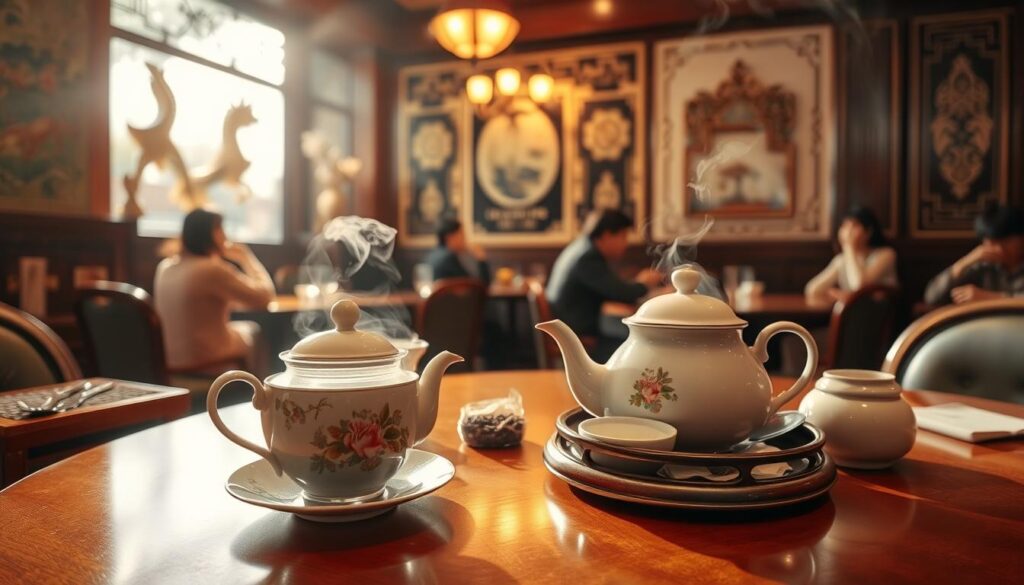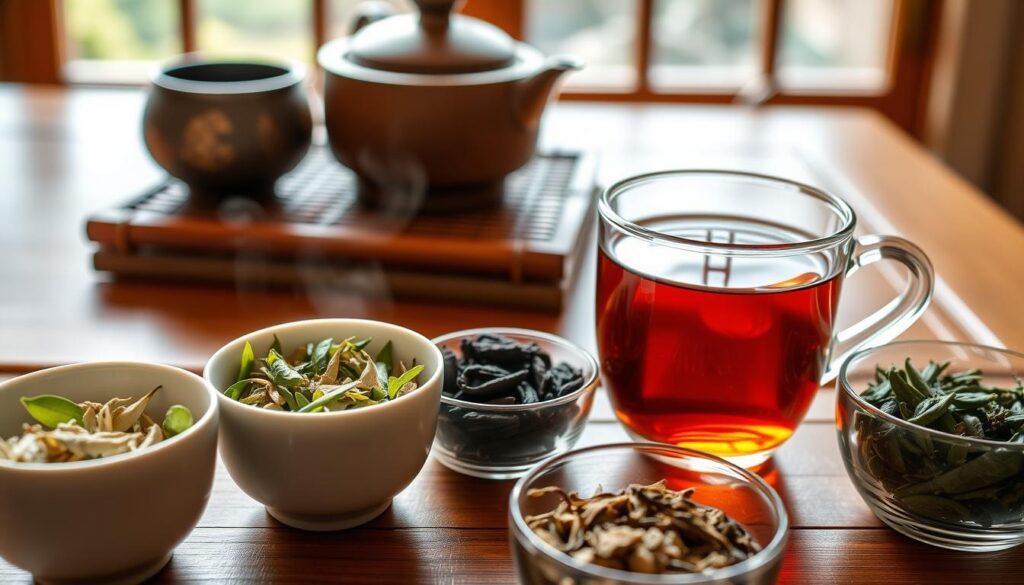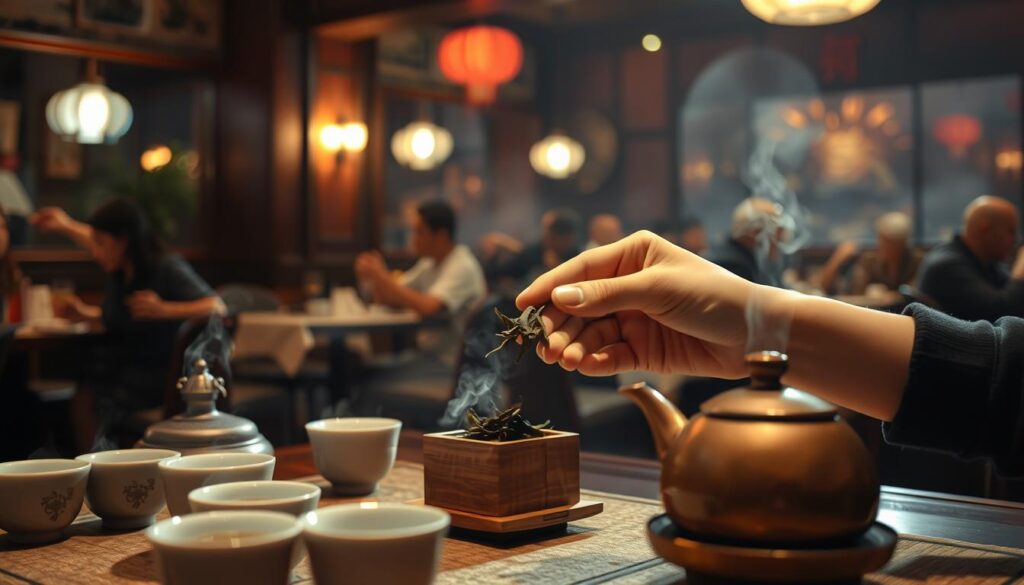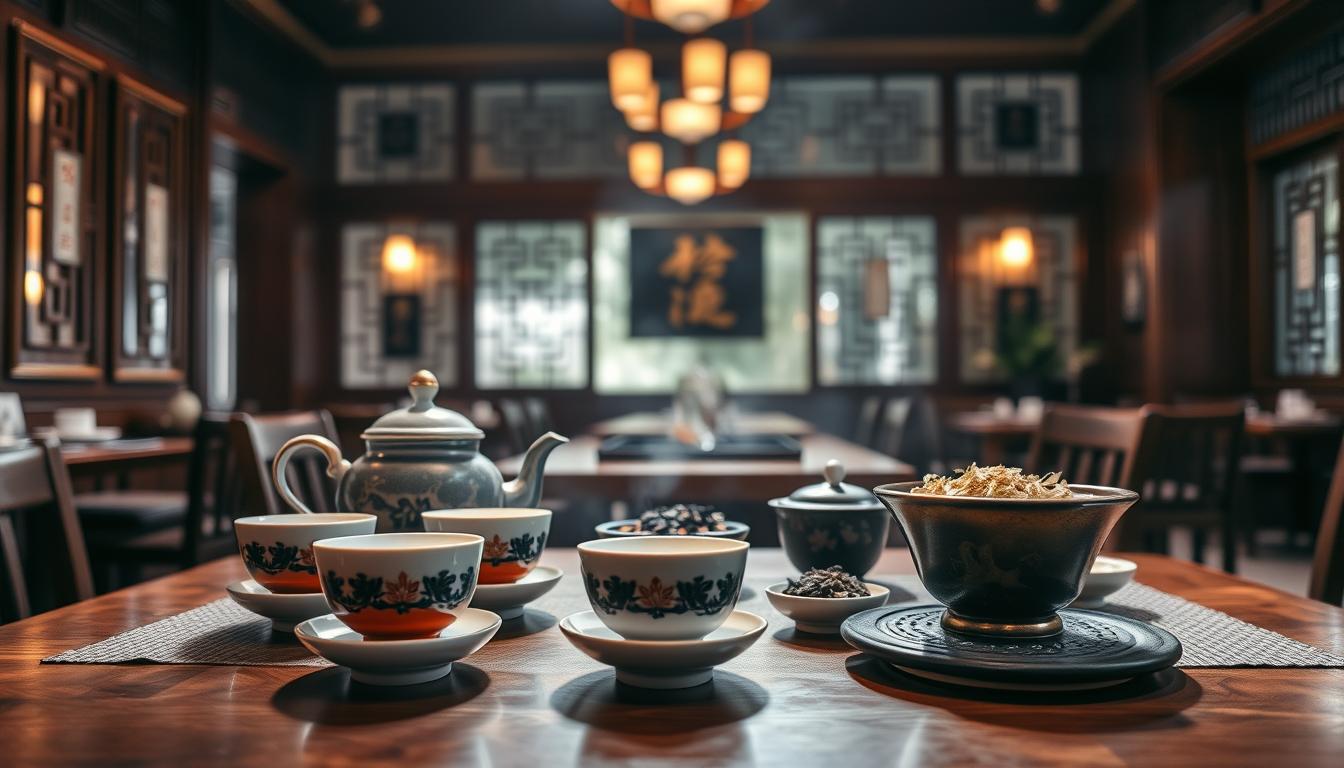Walking into a Chinese restaurant, you’re often greeted with a warm cup of tea. This simple gesture is more than just hospitality—it’s a cultural tradition that enhances the dining experience. The aroma of jasmine or the earthy notes of oolong can instantly transport you to the heart of Chinese tea culture.
Across different regions, the restaurant tea served may vary. In places like the SGV area of Los Angeles, you’ll often find teabag jasmine tea as a staple. However, some establishments might surprise you with unique blends like cooked pu’er or the delicate Tie Guan Yin. Each tea brings its own flavor profile and cultural significance to the table.
This article dives into the top five teas commonly found in Chinese restaurants. Whether you’re a tea enthusiast or just curious, you’ll learn to identify and appreciate these selections. Let’s explore the world of restaurant tea and discover what makes each one special.
Key Takeaways
- Jasmine tea is a popular choice, known for its sweet and floral aroma.
- Oolong tea offers a smooth, toasty flavor, often served during dim sum.
- Pu’er tea is earthy and bold, aiding digestion after meals.
- Chinese tea culture emphasizes fresh brewing without milk or sugar.
- Different regions may serve unique blends like Tie Guan Yin or cooked pu’er.
Understanding What Is the Tea Used in Chinese Restaurants
The moment you sit down, a warm cup of fragrant leaves is placed before you. This simple act is deeply rooted in culture, reflecting centuries of tradition. Across dining spaces, aromatic brews like jasmine or oolong are staples, enhancing the meal with their unique flavors.
Overview of Chinese Restaurant Tea Culture
Tea has been a cornerstone of dining experiences for centuries. In many eateries, it’s not just a beverage but a way to balance flavors. For example, green tea cuts through rich, fried dishes, while oolong complements dim sum perfectly. The ritual of serving tea also reflects respect and hospitality.
Regional customs add variety to this tradition. In Cantonese spaces, jasmine is often the go-to choice, while in Sichuan, chrysanthemum helps cool the palate. Flowers play a decorative and aromatic role, infusing brews with delicate scents.
Why Tea is Integral to the Dining Experience
Tea isn’t just a drink; it’s a cultural experience. It aids digestion, especially after heavy meals, and complements the cuisine’s bold flavors. At banquets, the continuous supply of hot brews ensures guests feel welcomed and satisfied.
For example, during dim sum, oolong is often served to cleanse the palate between bites. In high-end spaces, pu’er is a popular choice for its earthy notes and probiotic benefits. These traditions highlight the importance of tea in enhancing dining satisfaction.
| Tea Type | Flavor Profile | Common Use |
|---|---|---|
| Jasmine | Floral, Sweet | Dim Sum, Casual Dining |
| Oolong | Toasty, Nutty | Banquets, High-End Dining |
| Pu’er | Earthy, Bold | Post-Meal, Rich Dishes |
Exploring the Most Popular Chinese Restaurant Teas

When dining out, a steaming cup of aromatic brew often sets the tone for your meal. These selections are more than just beverages—they’re an essential part of the experience. From floral notes to earthy undertones, each variety complements the cuisine uniquely.
Jasmine Tea: Aroma and Appeal
Jasmine tea stands out for its sweet, floral scent. Its light, refreshing taste pairs perfectly with dim sum or fried dishes. The delicate aroma comes from jasmine flowers, which are layered with green tea leaves during processing.
This brew is a favorite in many dining spaces due to its ability to balance strong flavors. Its soothing qualities make it a go-to choice for casual meals or banquets. A well-prepared cup should have a clear, golden hue and a lingering fragrance.
Tie Guan Yin and Oolong: A Flavorful Bridge
Oolong and Tie Guan Yin offer a unique balance between green and black teas. Their partial oxidation process creates a rich, toasty flavor. Oolong is often described as nutty, while Tie Guan Yin has a smoother, more floral profile.
These teas are versatile, bridging the gap between bold and delicate dishes. During dim sum, they cleanse the palate between bites. In high-end spaces, they’re served to enhance the meal’s complexity.
- Jasmine Tea: Floral, sweet, and light—ideal for casual dining.
- Oolong: Nutty and toasty—perfect for banquets.
- Tie Guan Yin: Smooth and floral—a premium choice for special occasions.
Understanding these brews helps you appreciate their role in dining. Whether it’s the aroma of jasmine or the richness of oolong, each cup tells a story of tradition and flavor.
Tea’s Role in Enhancing Chinese Cuisine and Culture
From Hangzhou to Yanzhou, tea reflects regional identity and flavor. It’s not just a beverage but a cultural symbol that enhances meals and traditions. Each brew tells a story, connecting diners to centuries of heritage.
Cultural Traditions and Regional Differences
Tea has been woven into the fabric of Chinese culture for over 1,200 years. In Hangzhou, Longjing green tea is prized for its delicate flavor and historical significance. Its light, refreshing taste complements local dishes perfectly.
In Sichuan, chrysanthemum tea is a popular choice. Known for its cooling properties, it balances the heat of spicy cuisine. This herbal brew is often served with meals to soothe the palate.
Regional preferences highlight the diversity of Chinese tea culture. Whether it’s the floral notes of jasmine or the earthy richness of pu’er, each variety enhances the dining experience uniquely.
Balancing Flavors and Traditions
Tea plays a vital role in balancing flavors. Green tea, for example, cuts through rich, fried dishes, while oolong complements dim sum perfectly. Its toasty, nutty profile enhances the meal’s complexity.
Historically, tea was a medicinal product before becoming a cultural cornerstone. Today, it’s an integral part of dining etiquette, symbolizing hospitality and respect. Pouring tea for others first is a common practice, reflecting these values.
| Region | Tea Type | Flavor Profile |
|---|---|---|
| Hangzhou | Longjing Green Tea | Delicate, Refreshing |
| Sichuan | Chrysanthemum Tea | Cooling, Herbal |
| Yanzhou | Oolong Tea | Toasty, Nutty |
Understanding these traditions empowers you to appreciate tea’s role in Chinese cuisine. From its historical roots to its modern-day significance, each cup offers a glimpse into a rich cultural heritage.
Comparing Tea Varieties: From Jasmine to Pu-erh

Exploring the diverse world of Chinese tea reveals a spectrum of flavors and traditions. Each type brings its own unique characteristics, from floral notes to earthy undertones. Understanding these differences can help you choose the perfect brew for any meal.
Flavor Profiles and Brewing Techniques
Jasmine tea is known for its sweet, floral aroma. Its light, refreshing taste makes it ideal for casual dining. To brew, use water at 175°F and steep for 2-3 minutes for a delicate flavor.
Oolong offers a toasty, nutty profile. This partially oxidized type tea bridges the gap between green and black teas. Use water at 195°F and steep for 3-5 minutes to enhance its complexity.
Pu-erh stands out with its earthy, bold flavor. This fermented tea is perfect for rich dishes. Brew with boiling water and steep for 5 minutes to unlock its full depth.
When to Choose Each Tea for Your Meal
Pair jasmine tea with light dishes like steamed dumplings or stir-fried vegetables. Its floral notes complement subtle flavors without overpowering them.
For dim sum or roasted meats, opt for oolong. Its toasty profile cleanses the palate and enhances the meal’s richness.
After heavy meals, Pu Erh tea aids digestion and balances the palate. Its robust flavor pairs well with spicy or oily dishes.
- Jasmine Tea: Light and floral—perfect for casual meals.
- Oolong: Nutty and toasty—ideal for banquets.
- Pu-erh: Earthy and bold—best for post-meal digestion.
Understanding these varieties helps you appreciate their role in enhancing meals. Whether you prefer the lightness of jasmine or the richness of pu-erh, each type offers a unique experience. For more insights on Pu Erh tea, explore its unique fermentation process and health benefits.
Tips for Choosing and Enjoying Restaurant Tea

Selecting the right brew can elevate your dining experience, especially when exploring authentic flavors. Whether you’re sipping oolong or enjoying a floral chrysanthemum blend, understanding quality and preparation ensures a memorable meal.
Identifying Quality Tea Leaves
High-quality tea leaves are a key indicator of a well-prepared cup. Look for whole, unbroken leaves with a vibrant color. For example, green tea should have a fresh, grassy aroma, while black tea leaves should appear dark and glossy.
Poorly brewed options often use crushed or dusty leaves, resulting in a bitter taste. If your cup lacks aroma or clarity, it may indicate lower-grade tea leaves. Always trust your senses—quality brews should smell inviting and taste smooth.
Looseleaf vs. Teabag: What to Expect
Looseleaf varieties offer a richer experience compared to teabags. Whole leaves allow for better flavor extraction, creating a more complex taste. Teabags, while convenient, often contain smaller, broken leaves that can lead to over-brewing.
For example, a well-prepared Tie Guan Yin looseleaf will have a floral, lingering finish, while a teabag version might taste flat. If you’re unsure, ask your server about the tea preparation method—it can make a significant difference.
- Looseleaf: Whole leaves, richer flavor, ideal for special occasions.
- Teabag: Convenient, but may lack depth and aroma.
For more insights on pairing tea with meals, explore Chinese tea types to enhance your dining experience.
Conclusion
Exploring the rich flavors of Chinese tea culture reveals a world of tradition and taste. From the floral aroma of jasmine to the earthy depth of pu’er, each type offers a unique experience. These brews not only enhance meals but also reflect centuries of culinary heritage.
Choosing the right tea depends on your meal and personal preference. Light options like green tea pair well with delicate dishes, while robust oolong complements richer flavors. Quality leaves and proper brewing techniques ensure the best taste.
Whether you’re sipping a fragrant chrysanthemum flower blend or enjoying a bold black tea, each cup tells a story. Dive into this vibrant culture and discover how restaurant tea elevates dining. For more culinary adventures, explore Sakhuu Thai Cuisine and its immersive tours.

